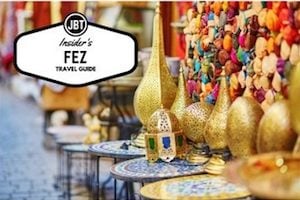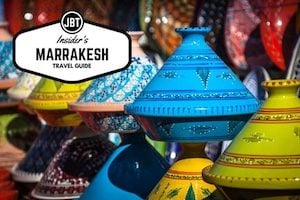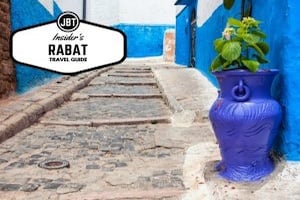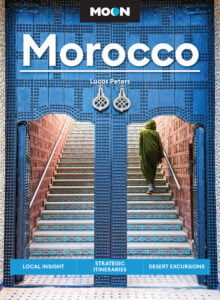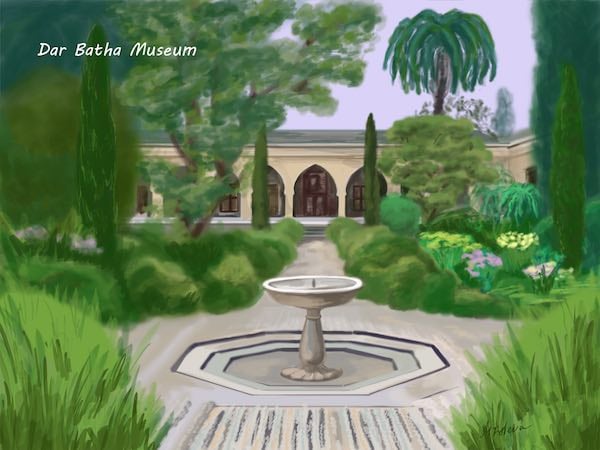
Arts and history enthusiasts simply can’t leave Fez without paying a visit to the incredible Dar Batha Museum, the city’s museum of traditional Moroccan arts. Set in a gorgeous 19th century palace, the building in itself could be considered a piece of art. Designed by Sultan Moulay Hassan, this Andalusian-Arabic style palace was occupied by two sultans before being repurposed as a museum in 1915. It features stunning zeillij tiling, intricate wood carvings, and a tranquil Andalusian garden where visitors can enjoy a peaceful break from the bustle of the medina. Within its walls however, lies the real treasure: one of the country’s finest collections of Moroccan decorative arts and artifacts dating to the 10th century.
The Original “Fez Blue”
The highlight of the Dar Batha Museum is undoubtedly the pottery room where you will find an extraordinary collection of ceramic objects crafted by Fez artisans over the course of centuries. The most notable artifacts are those dating to the 10th century, a time when Fez craftsmen discovered a relatively groundbreaking coloring technique using cobalt to create what is now traditionally known as “Fez Blue”. Pottery was often decorated in an intricate flower pattern motif, and these ceramic pieces also usually feature white enamel to highlight the stunning cobalt blue.
An Exquisite Collection
The extensive permanent collection at the Dar Batha Museum houses many interesting and historical decorative pieces of art and artifacts that all compete to grab the visitor’s attention. As with all traditional artwork, the pieces on display at the museum are often more practical in nature but feature beautiful decorative details to elevate them from simply functional to stylish design.
Visitors can delight in beautiful samples of carved wood, wrought iron, sculpted plaster and zeillij tiles from Morocco’s oldest medersas, or discover one of the country’s most complete collections of ancient coins. Stunning jewelry pieces, illuminated Korans, and antique instruments are also all on display.
An entire section is dedicated to famous Moroccan carpets, a true work of art developed by the Berber tribes across the country. These carpets often feature bright colors and designs that reflect Morocco’s rural landscape with its livestock and gardens. The ones on display at the Dar Batha Museum are from the Middle and High Atlas, as well as the Haouiz Plains.
Moroccan embroidery is also featured at this museum. Embroidery was a traditional pastime for wealthy Moroccan women and the Dar Batha Museum holds a beautiful collection of embroidered motifs, each with its own particular style. Typical pieces from Rabat will feature bright flower motifs and silhouettes of women in their patterns, whereas Aleju embroidery (more practiced in Fez) involves gold threading and red and blue nature motifs.
A final surprise awaits at the end of the tour in the astronomy room. This room features a collection of astrolables, a historic astronomic instrument developed and perfected by the Arabs between the 11th and 18th centuries. These instruments were typically used by astronomers, navigators, and astrologers for a number of purposes such as predicting the positions of sun, moon, planets, and stars, and calculating local time based on local latitude and vice-versa. Besides being incredibly functional, these instruments are also beautifully decorated with metal and inset jewelry.
After taking in all of the history from these traditional Moroccan artifacts, make sure to head over to the stunning Andalusian garden housed within the museum and delight in some tea and traditional sweets as you enjoy a beautiful view of the Fez medina.
If you would like to visit the Dar Batha Museum and see other highlights of Fez such as the Al-Qarawiyyin Mosque or Fondouk el-Nejjarine, feel free to start on our Morocco page to learn about how we can help you put together a unique tour. And, reach out to us to set up a private excursion unlike any other.

